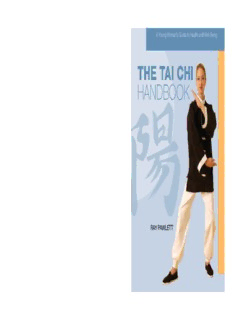
The Tai Chi Handbook PDF
Preview The Tai Chi Handbook
A Young Woman’s Guide to Health and Well-Being A HY o eu an ltg h W a no dm THE TAI CHI Wa n e ll-’s BG eu HANDBOOK inid ge t o T H E T A I C TITLES IN THIS SERIES H The Pilates Handbook I H Self-Defense for Women A N The Tai Chi Handbook D The Yoga Handbook B O O K RAY PAWLETT P ISBN-13: 978-1-4358-5360-7 a w le t t R O S E N A Young Woman’s Guide to Health and Well-Being Tai Chi The Handbook A Young Woman’s Guide to Health and Well-Being The Tai Chi Handbook Ray Pawlett NewYork Thiseditionpublishedin2010by: TheRosenPublishingGroup,Inc. 29East21stStreet NewYork,NY10010 Allrightsreserved.Nopartofthisbookmaybereproducedinanyformwithoutpermission inwritingfromthepublisher,exceptbyareviewer. LibraryofCongressCataloging-in-PublicationData Pawlett,Raymond. Thetaichihandbook/RayPawlett. p.cm.—(Ayoungwoman'sguidetohealthandwell-being) Includesbibliographicalreferencesandindex. ISBN-13:978-1-4358-5360-7(librarybinding) 1.Taichiforwomen—Handbooks,manuals,etc.I.Title. GV504.6.W66P392009 613.7'148—dc22 2009010316 ManufacturedinHongKong Copyright©2004D&SBooksLtd. Contents Introduction 6 1. The Roots of Tai Chi 13 2. The Origins of Tai Chi Styles 41 3. Tai Chi Practice: Getting Started 51 4. The Essence of Tai Chi 85 5. Tai Chi Styles 127 6. Martial Applications 179 7. What Happens Next? 227 Index 244 Credits and Acknowledgements 246 Bibliography 246 6 Introduction During thepast few decades, theart of taichihas spreadout of China. The style has not been limited to a select few: millions of people worldwide practice tai chi. Part of the reason for this diverse appeal is the wide scope of the art.Indeed, if you tryto define what tai chi actually is, you will arrive at apersonaldefinition that may well differ from that of someone else. ItiswiththisinmindthatIhavewrittenThe orheranddoyourbesttoavoidcausing TaiChiHandbook.Itsintentionistoofferthe injury.Note that the healingpractices readerinsightsacrossthescopeoftaichi describedinthisbookarenotintendedas ratherthaninformationononesingleaspect asubstituteforprofessionalmedicalcare. ofit.Althoughmymainbackgroundisinthe Yangschooloftaichiandfive-element shiatsu,Ihavealsostudiedmanyotherstyles ofmartialart,both“internal”and“external,” healingarts,alongwithTaoistartsand meditation,too. Theexercisesandexamplesinthisbook arewritteninawaythatwillenableyouto trythemforyourself.Alwaysbesensible, however:ifyouknow,orsuspect,thata certainmovementmaycauseyoutrouble, justskipituntilyoucanaskaprofessional practitioneroftaichiforadviceaboutit.Be carefulwiththeapplicationsaswell,and rememberthattheyarereal.Ifyouare trainingwithapartner,berespectfulofhim Introduction 7 What Is Tai Chi? Tai chiis an ancientChinese martialart systemthat is practiced throughouttheworldbyever-increasingnumbersofhighlyenthusiastic beginners and veterans of the art. The vast scopeof tai chi means that it is enjoyedby manycultures, young and old, fitand not so fit. Ifyoutrytosummarizetaichi,abasic The Tai Chi Class definitionisthatitisacombinationofa Alltaichischoolsfollowadifferentstyle. martialart,ahealingart,andaphilosophy. Justasdancevariesfromtangoandfoxtrot Eachoftheseaspectsisemphasizedin toballetandjazzdance,sotherearemany differentproportionsbyeachofthemillions diversestylesandvariationsencompassed oftaichipractitioners. bytaichi.Thetraditionalstyleswillcontain Itcanbesaidthattaichiitselfisevolving. elementsofthefollowing:health,martialart, From the “old days” of tai chi, thereare andmeditation. storiesof studentsbeing badlyinjuredin classesorhavingtoholdafixedpositionfor hourson end. Thistypeoftraining would beunrealisticformostmodernpeopleand times,andtechniquesaremuchchanged. Nowadays,learningtaichiisamorerefined andpleasurableprocess! Sowhatarethecommonaspectsoftai chipractice?Whatwillyougetfromyour training,andwhatdoyouneedtoputinto it?Ifthisbookcanhelpyoutoanswerthose twoquestions,orlookattheminadifferent way,thenyouwillhavemadestepsinyour taichiprogress. 8 TheTaiChiHandbook Health TaichiisfoundedintraditionalChinesehealing,whichusestheconceptofchitoexplain healthanddisease.Taichiissaidtobeexcellentfordevelopingyourchi,aswellashaving furtherhealthbenefits—welldocumentedintheworldofscience—suchasposture correctionandstressrelief. Martial Art Taichiasamartialartinvolveslearningapattern or“form.”Eachmovementintheformhasone ormoremartialapplications,whicharethen developedthroughexercises,suchaspushing handsorothertrainingdrills.Onceyouhave masteredbare-handtechniquesatahighenough level,youwillgetthechancetoexpandyour repertoirebylearningtaichiweapons. Meditation Themartialartapplicationsintaichiworkbetter ifyourbodyisrelaxedbecausethechicanmove morefreelyandyourbodywillmovemore efficiently.Yourtaichiteachershouldbeable toteachyousomemeditationpracticesthatwill helpyoutogaintheinnercontrolandrelaxation thattaichicanoffer. Introduction 9 Is It For Me, and What Do I Need? Duringthe yearsthat Ihave taught tai chi, Ihave had students of all shapes andsizes. The mostextreme cases that Icanremember area gentlemaninhiseightieswhoonlyhadoneeyeandaveryhighlyskilled tae kwon doexpert. Obviously, they were both looking fordifferent things from the class. The elderly gentleman was looking for some gentleexercise, andthe martial arts expertwanted to experience the martialarts that he alreadyknew from adifferent viewpoint. If, like mostpeople, youfall somewhere betweenthetwoextremes,thereisunlikely tobeaphysicalreasonforyounottryingtai chi.Ifyouareunsure,itisbesttoaskyour teacherordoctorwhethertaichipracticeis suitableforyou. Acommonimageoftaichiformany Westernersisthatoftheelderlygentleman ratherthanthemartialartist.Itisworth rememberingthatmuchhardworkis requiredtoreachtheloftyheightstowhich taichiaspires,sotherereallyshouldbe somethingforeveryone. Theequipmentneededfortaichiis minimal.Mostpeople(includingChinese Anyclothingthatallowsmovement masters)usuallytrainwearingeithershorts issuitablefortaichi.
Description: